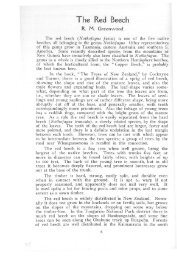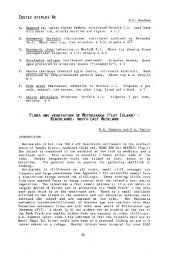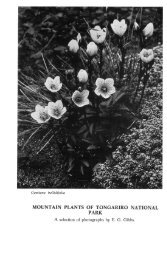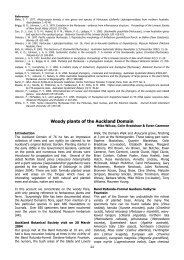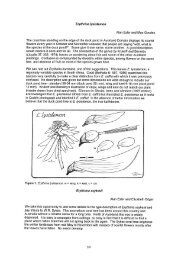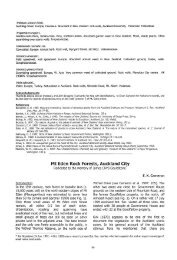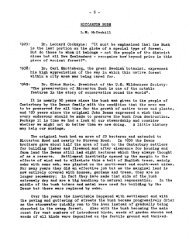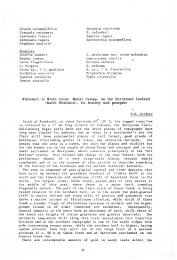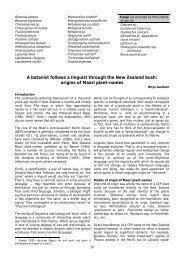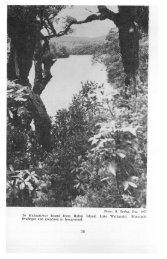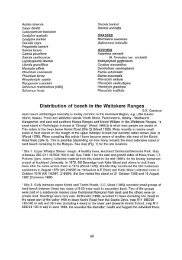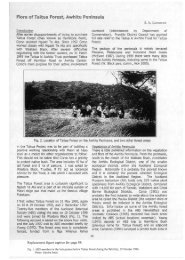Bulletin 48 cover - New Zealand Regional Botanical Society Journals
Bulletin 48 cover - New Zealand Regional Botanical Society Journals
Bulletin 48 cover - New Zealand Regional Botanical Society Journals
You also want an ePaper? Increase the reach of your titles
YUMPU automatically turns print PDFs into web optimized ePapers that Google loves.
The clerical botanist: Elwin Brodie DicksonRandal Springer 1EARLY DAYS AND THE FIRST YEAR IN NEW ZEALANDElwin Dickson was born in Pimlico, London, in 1828, son of Mary and JohnDickson, a London solicitor. Nothing is known of his younger days until heappeared on the roll of the Durham Cathedral Grammar School where he wonbooks as prizes for scholastic achievement during 1844 and 1845. After GrammarSchool he attended Durham University and gained his Bachelor of Arts degreewith High Classical Honours in 18<strong>48</strong>. He later passed the requisite examinationfor his Master’s degree (also with honours) but, as he put it, ‘[having] decidedto emigrate I left England before I was quite of sufficient standing to be admitted.’Here, too, he was awarded books as prizes for his achievements. In his will hebequeathed these to the library of St John the Evangelist in Auckland, now theKinder Library, where some may be found today. They have been described asbeing bound in full leather with elegant gold tooling on the spines. Some are inGreek and all have his bookplate pasted inside the <strong>cover</strong>.On 2 September 1853, Dickson wrote from Stockton on Tees to Sir W.J.Hooker at Kew claiming some knowledge of botany, advising of his intentionto emigrate and offering to collect specimens for the Royal Botanic Gardens.There is no record of Hooker’s reply.Dickson sailed to <strong>New</strong> <strong>Zealand</strong> in the barque Balnaguith, 462 tons, Capt A.Smith, leaving Gravesend on 24 December 1853 and arriving at Wellington on8 May 1854. His first known employment was at Wanganui where he wasengaged as tutor to the children of Captain Moses Campbell and his wife Jessie.The Campbells were very early settlers in Wanganui where Campbell was oneof the first four JPs gazetted in 1841. They were close friends of ReverendRichard Taylor and his family. Taylor was the missionary at Wanganui and hadan interest in the sciences especially geology and botany. By the time ofDickson’s arrival the Wanganui land sale had been completed and the Campbellshad moved out to settle on the block of land at Wiritoa which contains the lakeof that name, some 7 km southeast of Wanganui on what is now SH3.In the journals of Taylor’s two daughters, Laura and Mary, are references toDickson calling at the Putiki mission house. Laura Taylor wrote on 16 September1854, ‘A Mr Dixon called to see the garden’ and on 15 October, ‘Mr Dixonwalked to the beach with Papa so he invited him to dinner’(Springer, 1993).Her sister Mary wrote on 9 August 1855, ‘Mr Dixon came and slept.’ And onthe next day, ‘Mr Dixon cooly [sic] helped himself to plants and flowers togladden Miss Campbell he said when she arrived’ (Medley 1855).142 Dorset Road, Wanganui.51
What can we make of that last entry? The Miss Campbell was probably Louisa,then a nineteen year old, the eldest Campbell daughter. Louisa’s mother Jessie,a lady with definite views, probably did not encourage any familiarity betweenher daughter and the tutor. At about this time, and perhaps fortuitously, alongcame an old friend of both the Campbell and Taylor families, Donald McLean.By now well into his prime as a negotiator over land purchases on behalf of thegovernment, McLean arrived at the Campbell’s home and stayed a few days.This was the likely beginning of the long association between him and Dickson.THE PUBLIC SERVANT AND THE BOTANISTIn December 1855 McLean and Dickson travelled to Wellington on foot. Thefirst known botanical specimen in Dickson’s herbarium (his itinerary andcollections are given in Appendix 1) was collected on 24 December, a ferngathered from the Horokiwi Valley near Paekakariki. This valley leads fromthe top of the road above Paekakariki to the Pauatahanui Inlet, until 1940 theonly road to the north from Wellington. Dickson’s path can be traced by hiscollections, two more further down the valley on the same day and, once inWellington, another 13 about Wellington. Nearly all of these were collectedalong the Hutt Road as far as the ‘Hutt Bridges’ and all but one betweenChristmas and <strong>New</strong> Year’s Eve. The Hutt Road had just been uplifted elevenmonths previously by the major earthquake of January 1855, making space fora road to replace the narrow winding track which existed previously.On 24 January 1856, accompanying Donald McLean, Dickson crossed CookStrait bound for Port Underwood in the Old Jack, a 12 ton schooner of JohnGuard’s, with Guard in command (McLean 1856). McLean was to negotiatewith local Maori for purchase of land at the Wairau Bar and the Wairau Valley.The party stayed at Guard’s residence at Kakapo Bay during that period. On the25th they sailed to the mouth of the Wairau River to open negotiations. On the26th McLean sent word to Waitohi (now Picton) to make arrangements for thesettlement of claims about Arapawa Island. In his diary entry for that day herecorded that he and Dickson were entering arrears of their work in Wellington.During the stay at Kakapo Bay, which lasted until 5 February, Dicksoncollected another 16 specimens, six of them on the 27th at Kakapo Bay and thesurrounding cliffs. They were weatherbound due to a strong southerly blowinginto the bay and preventing them from continuing their business at the WairauBar. In the evenings they listened with interest to the Guards telling about theiradventures, especially the Harriet affair 2 . Dickson was to refer to these2 The Harriet was a whaling ship conveying Guard and his wife and family from Sydney to PortUnderwood when, on 29 April 1834, it was wrecked on the Taranaki coast near Opunake. Theship was plundered by local Maori and many of the passengers and crew were killed orwounded. An expedition to rescue the remainder was mounted in Sydney from where HMSAlligator was despatched to effect the rescue.52
discussions some 25 years later in response to an article in the ‘Auckland Weekly<strong>New</strong>s’. According to McLean, Dickson was occupied on 30 January by furtherclerical work, copying letters into a letter book and keeping accounts. On5 February, with the aid of oars, the party left Port Underwood and, catching abreeze when in the Strait, sailed round to Tory Channel and so to Waikawa.More plant specimens were collected at Waikawa, Waitohi and Tuamarina beforethe party set off for Nelson, specimens being collected en route at Anakiwa andOruapuputa on the Mahakipawa Arm of Pelorus Sound. A specimen wascollected in the ditches on the mud flat near the Saltwater Bridge, Nelson,between the town and the port on 13 March when Dickson and McLean left for<strong>New</strong> Plymouth and Auckland on the steamer Zingari. At <strong>New</strong> Plymouth therewas time for Dickson to collect one specimen from Mount Elliot, near the mouthof the Huatoki River.The Auckland newspaper Southern Cross reported the arrival of the Zingariat Onehunga on 15 March 1856 noting that amongst the passengers were MessrsMcLean and Dickson and 58 soldiers of the 57th Regiment. On 5 May Dicksonwas appointed a temporary clerk in the Native Secretary’s Office. He remainedin the Public Service in Auckland for the next eight years. In 1859 he moved tothe office of the Postmaster General (then in Auckland) and in 1862 to theposition of Secretary to the Post Office. In the Auckland jurors’ list for 1857 heis entered as a settler living at Coburg Street (now Kitchener Street which runsalong Albert Park), and on 8 July 1858, at St Matthews Church he marriedEmma Hill who was some years his senior. The site is now occupied by StMatthews in the City. Dickson and Emma had no children of their own but lateradopted a girl, Clara Phoebe.Within a fortnight of his arrival in Auckland, Dickson had gathered the firstof many specimens he was to collect during the remainder of this period inAuckland and which now comprise part of the collection in the Whanganui<strong>Regional</strong> Museum. His herbarium annotations show that he <strong>cover</strong>ed all of whatis now central Auckland, (including the area now occupied by Queen Street),Three Kings, Mount Eden, the Domain and the bays of the Waitemata fromMechanics Bay to Henderson. Specimens were also gathered on the CoromandelPeninsula from the vicinity of Coromandel and Whitianga. Five specimens wereobtained from Miner’s Bay, Great Barrier Island, on 20 October 1857.Late in 1859 Dickson assumed the additional responsibility of HonoraryCurator of the Auckland Museum, at that time located on Grafton Road, anunpaid employment he continued until September 1864. Accommodation wasattached and occupied by the Dicksons. In December 1861 he wrote a report onthe state of the Museum and its collection as he found it, together with suggestionsfor improvement. His comments were not complimentary (Dickson 1861).During May 1863 he despatched some fern spores to the Royal Botanic Gardensat Kew.53
On 1 October 1864 Dickson was transferred to <strong>New</strong> Plymouth as ChiefPostmaster, continuing until he was made redundant in 1869, the result ofretrenchment because of the financial position of Taranaki. During this periodhe collected more plant specimens. One of these, an unidentified ground orchid,was the subject of a letter from Dickson to an addressee thought to have beenJames Hector (St George & Hatch 1994). This plant is included in the Dicksoncollection in the Whanganui <strong>Regional</strong> Museum (ref. TB.002-6) and is stillunidentified.Dickson was warmly regarded by the people of <strong>New</strong> Plymouth. After hisdeath the Taranaki Herald of 3 August 1891 took the trouble to print an obituaryand noted that he was an ‘excellent Latin and Greek scholar and would repeatfrom memory page after page of some of the works of the ancient authors.’There are reports lauding his heraldic artistry in the preparation of illuminatedaddresses for various groups. He was a member of the Masonic Lodge andduring part of his time in <strong>New</strong> Plymouth was the Honorary Secretary of the<strong>New</strong> Plymouth Institute.While in <strong>New</strong> Plymouth Dickson received a letter from Thomas Kirk, writtenfrom his Auckland home in Karangahape Road on 18 February 1865, enclosinga fern specimen he had collected in the Waitakere Ranges and seeking Dickson’sidentification. A transcript of the letter is at Appendix 2. Towards the end of histime in <strong>New</strong> Plymouth Dickson applied for a position as librarian in the GeneralAssembly Library and wrote to Donald McLean soliciting his support. For somereason the vacancy seems to have been cancelled but McLean found a post as atutor which Dickson declined to accept. In thanking McLean, Dickson recalledhis dislike of this kind of employment (Dickson 1873).Returning to Auckland in 1869 Dickson was engaged again in the NativeSecretary’s Office and on 22 June that year left Auckland on the steamer Star ofthe South for Turanganui (now Gisborne) accompanying Judges Henry Munroand John Rogan as Clerk of the Court for the Poverty Bay Commission.Archdeacon W. L. Williams was also on board, returning home after an absenceof three months (Williams 1969). These were very unsettled times in Gisborne.Te Kooti had recently carried out the so-called Matawhero massacre and ablockhouse had very recently been erected, connected to the courthouse bydefensive works. Nevertheless, Dickson found time to collect another fivespecimens and another at Hicks Bay on the way home. The <strong>New</strong> <strong>Zealand</strong> Heraldreported the return to Auckland of the party on 21 August in the schooner Tawera.On board were Dickson, the two judges, four other passengers and 140 sheep,100 bags of wheat, 24 sides of bacon, 18 hams and 10 fowls! Hicks Bay wasprobably a call for shelter as the captain of the Tawera reported strong headwinds for the whole of the journey to Auckland.The last of the specimens in the Whanganui <strong>Regional</strong> Museum’s Dicksonherbaria were collected at Cox’s Creek, now part of the Cox’s Bay Reserve,54
Auckland, in January 1870. As far as is known the only other specimens Dicksoncollected are two in the Auckland Museum and Institute. These can be found inthe Cheeseman Herbarium, are undated, and were collected with J. Adam fromhot springs at Taupo and geysers at Wairakei.DICKSON’S HERBARIAThere are two herbaria of Dickson’s in the Whanganui <strong>Regional</strong> Museum. Oneis of ferns (Museum reference TB.003) and one of other genera (Museumreference TB.002). Together they contain over 225 specimens. Specimensgathered by other botanists are to be found in the collection, each beingacknowledged accordingly. One of interest is a fern collected by DrummondHay and Hochstetter. Although no date is recorded it can be dated as havingbeen collected in 1859 on the scientific expedition led by the latter withDrummond Hay as quartermaster and interpreter. The expedition, of which Haastwas also a member, left Auckland in December 1858 proceeding via Drury, theWaikato River, the lower Waikato region, Tokaanu, Orakei-Korako and theRotorua thermal areas, returning to Auckland in June 1859 (Bade 1993).Some of the names of the places where Dickson gathered specimens are nolonger in use, have been modified, or cannot be traced to a definite location.For instance Pito-one is now Petone and Waitohi is the old name for Picton. Inthe Auckland area his references to ‘gully beneath cemetery’, ‘cemetery gully’,‘Hobson’s glen’, and so on are almost certainly to the area now known as GraftonGully. It was not far from his residence at the time, as was the Infirmary whichwas in Albert Street. Ligar’s Gully was that area of central Auckland nowoccupied by Queen Street. Dickson’s references to Waipapa, Mangatoetoe andDilworth’s Station are probably to the area of Riverhead-Kumeu-Waitakerewhere James Dilworth had purchased some 2,000 acres near Waitakere in 1855(Brown 1995). Lucas Creek flows into the northwest Waitemata nearParemoremo. Herald Island near Whenuapai was in Dickson’s day known asWood’s Island after its owner at the time. Waihoihoi was near Drury.In the Coromandel area the Whangapaoa Line was probably the survey linenow followed generally by the road over the range from Coromandel to theWhangapaoa Harbour. Calloway’s Mile was near Kikowhakarere, after JohnCalloway, an early settler. Wynyard Diggings were in the vicinity of the presentColville Road and Kennedy Bay Road intersection. Te Ranga is now marked asspot height 510 m on modern topographical maps, some 5 km northeast ofCoromandel. Te Ranga (Davis’s Claim) is thought to have been in Little Paul’sCreek which runs into the Waiwhango River. What Dickson refers to as theHeretaonga Line is probably the line followed by the present Kennedy BayRoad which follows the course of the Harataunga Stream as it flows down intoKennedy Bay. Koputauaki, Kapanga and Wanganui Island are all in the vicinityof the Coromandel of today.55
The issue of the Southern Cross for 5 June 1876 contained an article on theAuckland Museum to which Dickson took exception, ‘rather on the score ofomission than mis-statement’. He went on to say:‘… a little injustice is done to my wife and myself by the entire absence ofany reference to the time between 1859 and 1864, when the collections were inmy charge. In November or December of the former year, I was requested byMr G. Eliot Elliot 3 acting on behalf of the Provincial Government and of thecontributors of specimens, to undertake charge of the collections which, sincethe removal of Mr J.A.Smith, were rapidly falling into decay, through the utterneglect in which they were then left, the persons resident on the premises beingentirely incompetent to preserve them in decent order. My first act wasnecessarily the removal and condemnation of several specimens of birds &c [sic],which had decayed beyond all remedy, leaving a legacy of moth and othervermin behind them, which were an incessant cause of labour and anxiety duringthe time I remained in charge, viz. until the end of September 1864. Of course,as I was at the time engaged in Government service, the main labour fell on mywife, to whose incessant care it is due that any of the original specimens—atleast of a perishable nature—is still existent.‘During this time my sole remuneration was the occupation of three smallrooms in the old dilapidated building, most of the ground attached to it not evenbeing fenced in, and what fencing there was being utterly decayed. No allowancewas at any time made for cleaning the rooms, much less for adding to thecollections, or for the requisite material for their preservation.’He went on to comment on the lack of care of the Museum during his term at<strong>New</strong> Plymouth, although a small grant was made to his successor, and to notethat he was ‘unaware of the nature of the services rendered to the Museum byDr. F. von Hochstetter, except that he left for it a series of duplicate specimens ofhis geological collections, which there was no room in the old building to displayand which with other things remained of necessity packed away during my time.’Late in 1880 Dickson became involved in a controversy via the media overthe subject of the Harriet following statements concerning it made by one JackyMarmon and printed in the Auckland Weekly <strong>New</strong>s. On 27 November he wroteto the editor expressing concern at some of the statements made by Marmonand, referring to his personal contact with the Guard family at Kakapo Bay in1856, gave his version of the affair. He also noted that Betty Guard was one oftwo women in <strong>New</strong> <strong>Zealand</strong> who had suffered terrible head wounds at the handsof Maori and survived, drawing attention of Wanganui readers to the other 4 .3 G. Eliot Elliot was, like Dickson, a senior officer in the Post Office and had also served in theNative Secretary’s Office. In 1863 he was sent to Sydney to recruit volunteers for the militarysettlements in Auckland. He moved to Welligton in 1864 (Scholefield 1940).4 Dickson is referring to Mary Gilfillan, daughter of J.A. Gilfillan who, despite a serious headwound, survived the Gilfillan incident in Wanganui in 1847.57
William Colenso then entered the fray claiming from his association with DrMarshall, surgeon of the Alligator, who wrote a book about the Harriet affair,that Dickson’s account from the Guards was not all correct (Bagnall 1980).Colenso’s lengthy letter was published in the Yeoman, Wanganui, on 8 January1881.Dickson’s duties with the Native Secretary’s Office still occupied his timeand in July 1882 he attended Judge O’Brien as Clerk of the Court at a sitting ofthe Court at Marton, returning to Auckland on 5 August.In 1887 Dickson was transferred to Wanganui as Registrar of the Maori LandCourt and where in weekends, he laid aside his administrative duties and assumedthose of a cleric. Dickson was admitted as a churchwarden at Christ Church inVictoria Avenue shortly after his arrival and the churchwarden’s register recordsthat he took many of the services. His Bible is now in the Whanganui <strong>Regional</strong>Museum. He had purchased it when attending Durham University. It is a 1607edition of a ‘breeches’ Bible 5 , inscribed by him with the date, January 18<strong>48</strong>,and with his bookplate inside the front <strong>cover</strong>. His bookplate is a winged heart ina clan belt in which is inscribed the motto ‘coleum versus’. In 1888 he againlaunched into print following a letter to the editor of the Wanganui Chronicleon 16 May. The occasion this time was a complaint by ‘A Friend’ over theclergy not being able to conduct the funeral of one G. Hately on a Sunday.Dickson wrote in the minister’s defence, saying that the parties knew the ministerhad a previous engagement and that had they asked he, as an authorised person,could have conducted the service for them.Emma died in Wanganui on 10 January 1888. Their daughter Clara, a talentedpianist, married John Charles Greenwood, a Wanganui dentist, on 16 July 1890.In the Yeoman of 26 July 1890 is a short news item which probably shedslight on the connection between the Museum and Dickson’s herbarium. It refersto a handsome casket on display in the window of Mr Drew’s shop in VictoriaAvenue. The casket was of the finest inlaid <strong>New</strong> <strong>Zealand</strong> timbers, with an ornatecarved lid and contained a silver-mounted, monogrammed album. It was madeby Mr Seuffert of Auckland and was the property of Mr E. B. Dickson. ObviouslyDrew and Dickson were acquainted and the connection with the Museum isthat Mr Drew was Samuel Drew, FLS, jeweller and watchmaker, who foundedthe establishment which has become the present Whanganui <strong>Regional</strong> Museum.It appears that Dickson’s herbaria have lain in the Museum for about the last100 years almost undisturbed. Considering the environment in which they werepreviously stored the specimens are in reasonably good condition much to thecredit of Dickson’s initial preparation.5 The first ‘breeches’ Bible was printed in Geneva in 1560—so named because in Gen iii, 7,‘breeches’ is printed in place of ‘aprons’.58
On 30 July 1891 Elwin Brodie Dickson died in Wanganui and was laid to restbeside his wife in the old Heads Road cemetery. The camellia growing on thegrave has been identified as ‘Purity’ which was introduced to <strong>New</strong> <strong>Zealand</strong> in1887.ACKNOWLEDGEMENTSIt has been my pleasure to receive help from many people in my research onDickson (sometimes spelt Dixon and his christian name often transcribed asEdwin). My thanks to my wife June whose help and support made the tasks somuch easier, to Colin Ogle of Department of Conservation, Wanganui, whoinadvertently started the project, and helped to finish it off by confirming thecurrent identification of the specimens, and to the always helpful staff of theWhanganui <strong>Regional</strong> Museum. Also in Wanganui, Vonnie Cave who identifiedthe camellia growing on Dickson’s grave. In Auckland, Jenifer Curnow, EwenCameron and Anthony Wright (now of Canterbury) of the Auckland Instituteand Museum, Diana Masters, Auckland Historical <strong>Society</strong>, Jan Bell, AucklandCity Library and Judith Bright of the Kinder Library. Also to David Phillip,Coromandel School of Mines and Historical <strong>Society</strong>, Mary Donald, TaranakiMuseum, and Robin Startup of Masterton. In Wellington, Stuart Park and FionaPitt (now retired) of MONZ, Dr Ian St George, the staff at the Alexander TurnbullLibrary and at National Archives and at Nelson, David Blick, Nelson PublicLibrary. At Ohakune, Dorothy Battersby and in the UK, Mrs C A Piggott,Archivist at the Royal Botanic Gardens, Kew.REFERENCESBade, J.N. 1993: The German Connection, p. 154–155. Auckland.Bagnall, A.G. 1980: <strong>New</strong> <strong>Zealand</strong> National Bibliography, Vol. 1, p. 287, 633. Wellington.Brown, J.M. 1995: Journal of the West Auckland Historical <strong>Society</strong>, <strong>New</strong>sletter 175: 10–14.Dickson, E.B. 1861: Report to the superintendant of Auckland Museum. Unpublished report heldby Auckland Institute and Museum.Dickson, E.B. 1873: Letter from Dickson to McLean. In: McLean, D. papers MS 0032-0244,Alexander Turnbull Library, Wellington.McLean, D. 1856: papers, MS 1215-1282, Alexander Turnbull Library, Wellington.Medley, M.C. (nee Taylor) 1855: papers 1854–1901, journal entry (MS 3762) Alexander TurnbullLibrary, Wellington.Scholefield, G.H. 1940: A Dictionary of <strong>New</strong> <strong>Zealand</strong> Biography. Vol 1. Wellington. Pp 228-229.Springer, R. 1993: The Missionary’s Daughter. Wanganui 135: 141.St George, I. and Hatch, E. 1994: <strong>New</strong> <strong>Zealand</strong> Native Orchid Group Journal No. 50: 8–9.Williams, W.L. 1869: <strong>Journals</strong>, 1865–1871, Micro 628, Reel 2. Alexander Turnbull Library,Wellington.59
APPENDIX 1Dickson’s itinerary and plant collectionsThe following is Dickson’s itinerary, with his identification and spelling (n.d. =no date) and the current identification as at December 2000. The figures in thefifth column indicate the Whanganui <strong>Regional</strong> Museum’s reference, abbreviatedby omitting the TB.00 from the series number, e.g., 3.57 = TB.003.57.Date Location Dickson’s identification Museum Current nameref.1855Dec 24 Horokiwi Valley 1 Asplenium Richardi 3.57 Asplenium hybrid24 Horokiwi Valley Fern - no inscription 3.73 Asplenium colensoi24 Horokiwi Valley, Porirua Uncinia Ferruginea 2.20 Uncinia ferruginea30 Hutt Road Arthropodium Candidum 2.13 Arthropodium candidum30 Hutt Bridges Isolepis Prolifer 2.17 Isolepis inundata30 Nr Hutt Bridge Isolepis Riparia 2.18 Isolepis pottsii30 Cliffs nr Kaiwarawara Triticum Scabrum 2.31 Elymus solandri30 Gully on Hutt Road Craspedia Fimbricata 2.64 Craspedia uniflora var.maritima30 Gully nr Pito-one Gnaphalium Keriense 2.67 Anaphalioides trinervis30 Hutt Road nr Pito-one Lobelia Anceps 2.73 Lobelia anceps30 Hutt Rd in the gullies Plantago Raoulii 2.96 Plantago raoulii30 Gullies on Hutt Road Luzula Campestris 2.14 Luzula banksiana var.banksiana31 Nr Hutt Bridge Gahnia Lacera 2.19 Carex secta var. secta31 Swamp nr Hutt Bridge Carex Forsteri 2.21 Carex maorican.d. Nr Hutt Bridge Carex Dissita 2.22 Carex dissita1856Jan n.d. Nr Wellington Trichomanes Venosum 3.80 Trichomanes venosumn.d. Wellington Hymenophyllum Oruginosum 3.107 HymenophyllumferrugineumJan 25 Kakapo, Port Underwood Poa Imbecilla 2.29 Poa imbecilla26 Kakapo, Port Underwood Tillaea Verticillaris 2.42 Crassula sieberiana27 Kakapo, Port Underwood 2 Asplenium Adiantoides 3.72 Asplenium hookerianum s.s.27 Kakapo, Port Underwood 3 Asplenium Flabellifolium 3.172 Asplenium flabellifolium27 Kakapo, Port Underwood 4 Polycarpon Tetraphyllum 2.10 Polycarpon tetraphyllum27 Kakapo, Port Underwood Rhipogonum Scandens 2.11 Ripogonum scandens27 Kakapo, Port Underwood Metrosideros Hypericifolia 2.47 Metrosideros diffusa27 Kakapo, Port Underwood Apium Filiforme 2.55 Apium prostratum ssp.prostratum var. prostratum29 Boulder Bank, Wairau 5 Gypsophila Tubulosa 2.8 Gypsophila australisFeb 2 Boulder Bank, Wairau Cheilanthes Tenuifolia 3.159 Cheilanthes humilis2 Wairau River Mouth Selliera Radicans 2.74 Selliera radicans3 Boulder Bank, Wairau Colobanthus Subulatus 2.9 Scleranthus biflorus3 Boulder Bank, Wairau 6 Convolvulus Erubescens 2.87 Convolvulus verecundusssp. waitaha3 Boulder Bank, Wairau Raoulia Australis 2.66 Raoulia hookerii3 Boulder Bank, Wairau Pimelea Virgata 2.102 Pimelea urvilleana3 Boulder Bank, Wairau Pimelea Prostrata 2.103 Pimelea urvilleana1 Near Paekakariki.2 On cliffs, Guard’s Bay.3 On cliffs, Guards Bay.4 Probably introduced from Australia.5 Perhaps a doubtful native.6 Near South Bluff.60
3 South Bluff, Wairau Veronica Ligustrifolia 2.91 Hebe parviflora5 Wairau River Mouth Eryngium Vesiculosum 2.56 Eryngium vesiculosum6 Waitohi 7 Veronica Elliptica 2.92 Hebe divaricata6 Waikawa Veronica Salicifolia 2.90 Hebe stricta var. atkinsonii7 Waikawa 8 Tmesipteris Forsteri 3.178 Tmesipteris elongata7 Waikawa Dodonaea Viscosa 2.37 Dodonaea viscosa8 Waikawa Lycopodium Volubile 3.194 Lycopodium volubile10 Tuamarina Road 9 Lycopodium Scariosum 3.201 Lycopodium scariosum10 Tuamarina Pass Oxalis Magellanica 2.35 Oxalis magellanica11 Anakiwa Chenopodium Triandrum 2.97 Atriplex buchananii12 Anakiwa Line 10 Hymenophyllum Tunbridgense 3.81 Hymenophyllum revolutumMar 13 Oruapuputa, Pelorus Metrosideros Scandens 2.<strong>48</strong> Metrosideros perforata13 Saltwater Bridge, Nelson 11 Mimulus Repens 2.89 Mimulus repens15 Mt Elliot, <strong>New</strong> Plymouth Panicum Sanguinale 2.26 Cynodon dactylonApr 1 Freeman’s Bay Lycopodium Densum 3.186 Lycopodium deuterodensum5 Gully underneath Cemetery Lygodium Articulatum 3.32 Lygodium articulatum13 Mt Eden Pteris Falcata 3.121 Pellaea falcata20 Mt Eden Pteris Tremula 3.128 Pteris tremula20 Mt Eden Peperomia Urvilleana 2.104 Peperomia urvilleana20 Nr top of Mt Eden Leucopogon Frazeri 2.78 Leucopogon fraseriApr n.d. Domain Goniopteris Pennigera 3.40 Pneumatopteris pennigeran.d. Parnell Hill Doodia Aspera 3.189 Doodia australisAug 9 Cliffs, Freeman’s Bay Lomaria Procera 3.1<strong>48</strong> Blechnum novae-zelandiae9 Cliffs, Freeman’s Bay Lycopodium Cernuum 3.199 Lycopodiela cernua13 Wood’s Island, Waitemata Lindsaea Linearis 3.14 Lindsaea linearis13 Wood’s Island, Waitemata Gleichenia Semivestita 3.134 Gleichenia microphylla13 Wood’s Island, Waitemata 12 Lycopodium Laterale 3.183 Lycopodiella lateralis13 Lucas’s Creek Nipholobus Rupestris 3.53 Pyrrosia eleagnifolia17 Gully beneath Cemetery Polystichum Hispidum 3.21 Lastreopsis hispida17 Cemetery Gully Phymatodes Billardieri 3.46 Microsorum pustulatum17 Cemetery Gully Stenochlaena Heteromorpha 3.99 Blechnum filiforme17 Gully under Cemetery Leptopteris Hymenophylloides 3.165 Leptopterishymenophylloides17 Ligar’s Gully Asplenium Bulbiferum 3.65 Asplenium gracillimum24 The Cemetery Pteris Scaberula 3.3 Paesia scaberula24 Ligar’s Gully Lomaria Membranaceae 3.7 Blechnum membranaceum24 Ligar’s Gully Cyathea Dealbata 3.91 Cyathea dealbata24 Ligar’s Gully Dicksonia Squarrosa 3.146 Dicksonia squarrosa24 Ligar’s Gully Lomaria Frazeri 3.153 Blechnum fraseri24 Ligar’s Gully Leucopogon Fasciculatus 2.77 Leucopogon fasciculatusSep 13 Domain Oxalis Corniculata 2.34 Oxalis corniculata13 Domain Doodia 3.190 Doodia australis14 Mt Eden Drosera Auriculata 2.44 Drosera peltata ssp.auriculata14 Mt Eden Coprosma Lucida 2.58 Coprosma robusta14 Mt Eden Dictymia Lanceolata 3.50 Anarthropteris lanceolata16 Nr Henderson’s Mill, Wtma Lycopodium 3.192 Lycopodiella lateralis17 Swamps, Wtma & Whau Drosera Binata 2.43 Drosera binata17 The Whau Lycopodium Densum 3.184 Lycopodium deuterodensum17 Waipapa, Waitemata Hymenophyllum Polyanthos 3.83 Hymenophyllumsanguinolentum17 Waipapa Hymenophyllum Rarum 3.87 Hymenophyllum rarum7 Round the beach.8 Epiphytic on trunks of ‘ponga’.9 Between Waitohi and Wairau.10 Mostly on the ‘ponga’ and ‘mamaku’.11 Ditches on the mud flat.12 Wet banks: among very long grass.61
17 Waipapa Hymenophyllum Flabellatum 3.88 Hymenophyllumflabellatum17 Waipapa Trichomanes Reniforme 3.94 Trichomanes reniforme17 Mangatoetoe, Dist of Wtma Lomaria Discolor 3.13 Blechnum discolor17 Mangatoetoe, Dilworth Stn Lycopodium 3.193 Lycopodiella lateralis18 Mangatoetoe Schizaea Bifida 3.37 Schizaea bifida18 Mangatoetoe Schizaea Propinqua 3.38 Schizaea fistulosa18 Waipapa, Waitemata Asplenium Flaccidum 3.61 Asplenium flaccidum18 Waipapa, Waitemata Hymenophyllum Dilatatum 3.75 Hymenophyllum dilatatum26 Domain Lomaria Lanceolata 3.9 Blechnum chambersii28 Ligar’s Gully Asplenium Bulbiferum 3.66 Asplenium flaccidum × A.gracillimumSep n.d. Waipapa Lygodium Articulatum 3.35 Lygodium articulatumn.d. Whau Bridge Gaultheria Antipoda 2.75 Gaultheria antipodan.d. Nr Whau Bridge Cyathodes Acerosa 2.76 Cyathodes juniperinan.d. Waipapa, nr Waitakerei (sic) Corokia Buddlaeoides 2.57 Corokia buddleioidesOct 19 Caverns at Three Kings Nephrodium Decompositum 3.25 Lastreopsis glabella19 Three Kings 13 Asplenium Bulbiferum 3.67 Asplenium gracillimum19 Caves at Three Kings Trichomanes Humile 3.95 Trichomanes venosum19 Caves at Three Kings Asplenium Flabellifolium 3.173 Asplenium flabellifolium19 Caverns on Three Kings Doodia 3.191 Doodia australis25 Rocks, Freeman’s Bay Lomaria Vulcanica 3.11 Blechnum vulcanicum25 Hobson’s Glen Lycopodium Billardieri 3.202 Huperzia varia26 Hobson’s Glen Polystichum Aristatum 3.18 Polystichum richardiiOct n.d. Mt Eden Pteris Rotundifolia 3.12 Pellaea rotundifolian.d. Cemetery Gully Asplenium Lucidum 3.169 Asplenium oblongifoliumNov 8 Lava nr Three Kings Cheilanthes Tenuifolia 3.159 Cheilanthes humilis9 Gully nr Infirmary Doodia Caudata 3.188 Doodia australis17 Karangahape Road Lindsaea Linearis 3.14 Lindsaea linearisn.d. Hobson’s gully Cordyline Banksii 2.12 Cordyline banksiin.d. Hobson’s gully Panicum Imbecille 2.25 Oplismenus imbecillusn.d. Ligar’s Gully Carmichaelia Australis 2.33 Carmichaelia australisn.d. Domain Epilobium Nummularifolium 2.51 Epilobium nerteroidesn.d. Domain Rubus Australis 2.40 Rubus cissoidesn.d. Mount Eden 14 Bidens Pilosa 2.61 Bidens pilosan.d. Franklin Road Pomaderris Phylicifolia 2.36 Pomaderris ericifolian.d. Mangere Nephrodium Squamulosum 3.30 Thelypteris confluens1857Jan 1 Kikowhakarere Pteris Macilenta 3.120 Pteris macilenta2 Whangapoua Line, Merc Bay Hymenophyllum Scabrum 3.77 Hymenophyllum scabrum2 Hills above Kapanga 15 Lycopodium Densum 3.184 Lycopodium deuterodensum5 Whitianga Line, rock &c 16 Grammitis Australis 3.54 Grammitis ciliata5 Nr Whitianga, Mercury Bay Lycopodium Densum 3.187 Lycopodium deuterodensum6 Heretaonga Line Polypodium Grammitidis 3.45 Ctenopteris heterophylla6 Heretaonga Line Arthropteris Tenella 3.51 Arthropteris tenella6 Heretaonga Line Trichomanes Elongatum 3.78 Trichomanes elongatum6 Heretaonga Line Lindsaea Trichomanoides 3.104 Lindsaea trichomanoides6 Heretaonga Line Marattia Salicina 3.160 Marattia salicina6 Coromandel Hymenophyllum Rarum 3.87 Hymenophyllum rarum6 Nr Kennedy Bay Earina Mucronata 2.1 Earina mucronata8 Kikowhakarere Stenochlaena Heteromorpha 3.102 Blechnum filiforme8 Kikowhakarere Hymenophyllum Demissum 3.108 Hymenophyllum demissum9 Wynyard Diggings Pteris Vespertilionis 3.132 Histiopteris incisa9 Wynyard Diggings Tmesipteris Forsteri 3.178 Tmesipteris elongata13 Caves in lava and scoria.14 A doubtful native.15 In manuka scrub.16 Rock in bush.62
12 Kikowhakarere Lomaria Fluviatilis 3.6 Blechnum fluviatile12 Coromandel Lomaria Discolor 3.13 Blechnum discolor12 Kikowhakarere Polypodium Rugulosum 3.42 Hypolepis lactea13 Kikowhakarere Nephrodium Decompositum 3.29 Lastreopsis microsora13 Pohokeno Island Adiantum Hispidulum 3.114 Adiantum hispidulum13 Coromandel Lomaria Frazeri 3.153 Blechnum fraseriJan n.d Kikowhakarere Rhabdothamnus Solandri 2.95 Rhabdothamnus solandrin.d Coromandel Nesodaphne Tawa 2.99 Beilschmiedia tawaOct 20 Miners Bay Gt Barrier Is Lomaria Lanceolata 3.10 Blechnum chambersii20 Miners Bay Gt Barrier Is Nephrodium Velutinum 3.23 Lastreopsis velutina20 Miners Bay Gt Barrier Is Adiantum Cunninghamii 3.110 Adiantum viridescens20 Miners bay Gt Barrier Is Adiantum Cunninghamii 3.111 Adiantum fulvum20 Miners Bay Gt Barrier Is Pteris Comans 3.126 Pteris comans20 Miners Bay Gt Barrier is Cyathea Medullarus 3.144 Cyathea medullaris1858May n.d. Nr top of Hobson’s Gully Elatostemma Rugosum 2.101 Elatostema rugosumn.d. Freeman’s Bay Asplenium Obtusatum 3.168 Asplenium northlandicum1859Jan 1 Whanganui Island 17 Pteris Macilenta 3.123 Pteris saxatilis6 Koputauaki Lycopodium Billardieri 3.203 Huperzia varia9 Wynyard Gold Diggings Pteris Scaberula 3.5 Paesia scaberula10 Coromandel Phymatodes Pustulatum 3.49 Microsorum scandens12 Kikowhakarere Hypolepis Tenuifolia 3.97 Hypolepis ambigua13 Pohokeno Island Clianthus Puniceus 2.39 Clianthus puniceusNov 14 Waihoihoi Hymenophyllum Crispatum 3.74 Hymenophyllum flexuosum1862Jan n.d Pohokeno Island Entelea Arborescens 2.23 Entelea arborescensn.d. Auckland Thelymitra Longifolia 2.7 Thelymitra longifolian.d. Domain Adiantum Affine 3.116 Adiantum diaphanum1863Jan n.d. Ranges nr Kennedy Bay Hymenophyllum Crispatum 3.74 Hymenophyllum flexuosumn.d. Koputauaki Creek Trichomanes Venosum 3.80 Trichomanes venosumn.d. Kennedy Bay 18 Loxsoma Cunninghamii 3.89 Loxsoma cunninghamiin.d. Te Ranga, Davis’ Claim Hymenophyllum Oruginosum 3.107 Hymenophyllumferrugineumn.d. Te Ranga Lycopodium Varium 3.197 Huperzia varian.d. Kikowhakarere Cyathea Cunninghamii 3.143 Cyathea cunninghamiin.d. Kikowhakarere Persoonia Toro 2.98 Persoonia torun.d. Coromandel Davallia Novae Zelandiae 3.15 Leptolepia novae-zelandiae1866Jul 25 Mikotahi, in ruas Lomaria Banksii 3.1 Blechnum banksiiOct 21 Henui River 19 Gunnera Monoica 2.45 Gunnera monoica21 Bush on Henui River Phymatodes billardieri 3.47 Microsorum scandens21 Bush on Henui River Lomaria Elongata 3.117 Blechnum colensoiNov 4 Huatoki River 20 Pterostylis Nov. Sp. 2.6 Not identified23 Mikotahi Dichelachne Crinita 2.27 Dichelachne crinita23 Mikotahi Apium Australe 2.54 Apium prostratum ssp.prostratum var. prostratum23 <strong>New</strong> Plymouth Cotula Coronopifolia 2.62 Cotula coronopifolia23 Mikotahi Senecio Lautus 2.71 Senecio lautus23 Mikotahi Samolus Litteralis 2.82 Samolus repens23 Moturoa Convolvulus Soldanella 2.86 Calystegia soldanella23 Mikotahi Dichondra Repens 2.88 Dichondra repens17 Beeson’s homestead.18 On path from Koputauaki to Heretaonga.19 Wet spots in bush.20 Boggy ground about 1.5 miles from town.63
25 <strong>New</strong> Plymouth Geranium Microphyllum 2.32 Geranium potentilloidesDec n.d. Ruatangata, <strong>New</strong> Plymouth Pelargonium Australe 2.33 Pelargonium inodorumn.d. Ruatangata Microtis Porrifolia 2.4 Microtis unifolian.d. <strong>New</strong> Plymouth 21 Pterostylis Graminea 2.5 Pterostylis banksiin.d. <strong>New</strong> Plymouth 22 Cotula Australis 2.63 Cotula australisn.d. <strong>New</strong> Plymouth Nephrodium Decompositum 3.26 Lastreopsis glabellan.d. Woodleigh Stenochlaena Heteromorpha 3.101 Blechnum filiforme1867Apr 9 Woodleigh Asplenium Falcatum 3.174 Asplenium polyodon1868Jan n.d. Paritutu Cassinia Retorta 2.65 Olearia solandrin.d. Coad’s Clearing Leptopteris Superba 3.164 Leptopteris superbaFeb n.d. Near base of Mt Egmont Celmisia Longifolia 2.59 Celmisia gracilenta var.[unnamed]Nov 5 Pheney’s Bush, Ratanui Hymenophyllum Crispatum 3.74 Hymenophyllum flexuosum9 Pheney’s Bush, Ratanui Hydrocotyle Moschata 2.53 Hydrocotyle moschata1869Jun 28 Gully nr Turanganui Fuchsia Excorticata 2.50 Fuchsia excorticataJul n.d. Gullies nr Turanganui Hoheria Populnea 2.16 Hoheria populnean.d. Gully nr Turanganui Gnaphalium Luteo-album 2.68 Pseudognaphalium sp.[unnamed] (P. luteoalbumagg.)n.d. Turanganui Erechtites Arguta 2.69 Senecio glomeratusn.d. Turanganui Botrychium Circutarium 3.155 Botrychium australeAug 13 Hick’s Bay Parietarea Debilis 2.100 Parietaria debilis1870Jan n.d. Cox’s Creek, Waitemata 23 Plagianthus Divaricatus 2.15 Plagianthus divaricatusn.d. Cox’s Creek, Waitemata Leucopogon Fasciculatus 2.77 Leucopogon fasciculatus21Woods near Upjohn’s, Henui.22Waste ground.23On the beach.64
APPENDIX 2Two letters to E.B. Dickson.The first is in a private collection of Dickson’s books which contains a copy ofan 1859 edition of Milton’s ‘L’ALLEGRO & IL PENSEROSO’, illustratedwith etchings in steel by Birket Foster. Pasted in between the fly and the front<strong>cover</strong> is the following letter:Dear DicksonAs it is possible I may not again have the pleasure ofseeing you at least for a long time will you accept thissmall token of the esteem with which I shall ever continueto regard you. I hope you are not already in possession ofa copy of the same book but if so I am sure you will acceptthe will for the deed.E B Dickson, Esq.Believe meYours ever trulyJ G Anderson26 Sept 1864Research has so far failed to identify the writer who obviously knew that Dicksonwas about to leave Auckland for <strong>New</strong> Plymouth to take up the position of ChiefPostmaster there.The second letter is from Thomas Kirk asking for Dickson’s identification ofan enclosed fern specimen. Both the letter and the fern are in the Whanganui<strong>Regional</strong> Museum. The fern had been identified as Lindsaea linearis.Karangahape RoadAuckland18th February 1865My dear SirCan you identify the enclosed? At first sight of thefern when growing I supposed it to be Davallia Schimperior D Lindeni – however in the hasty examination I havehad time to make I have only been able to come to thecertain conclusion of my own ignorance.65
I have just had a days ramble to the Titirangi Ranges& picked the plant when walking home – in the bottom ofa deep gully – with deep water holes – I picked but littleand my species [sic] are immature. More luxuriant oneswere in view but could only be reached by wading – ashowever it was dusk and I had a walk of at least 8 milespartly over unknown ground before me – the acquisitionof a better supply was postponed for a more favourableopportunity.My health has improved not a little during the last fewdays – wife however does not gain strength as could bewished.Hooker’s Handbook not yet in Auckland & I have noinformation about it as yet. With kind regards to MrsDickson and yourself.E. B. DicksonYours sincerelyThomas KirkI fear the fronds will be somewhat shrivelled as theyare but just picked.APPENDIX 3Maori names ascribed to plants by Dickson as recorded on his herbariumsheets.It is not known if Dickson was fluent in te reo Maori but the possibility existsfrom his close association with Maori through his employment, especially inAuckland and Coromandel. In the Whanganui <strong>Regional</strong> Museum is an albumof his which contained many photographs of Maori. Many have been removedbut those that remain are mainly photographs of chiefs of the Wanganui areawho were living when Dickson arrived in Wanganui in 1854.The following list taken from Dickson’s herbarium sheets gives the Maoriname(s) of plants which he recorded. The name of the tribe where it was givenis also included. The botanical name in the list is the current identification ofthe plant (as at December 2000) and the reference on the left is the abbreviatedWhanganui <strong>Regional</strong> Museum serial number.2.11 Ripogonum scandens Kareao37 Dodonaea viscosa Akeake66
40 Rubus cissoides Pataramoa58 Coprosma robusta Karamu77 Leucopogon fasciculatus Totara90 Hebe stricta Koromiko95 Rhabdothamnus solandri Kaikai-atua3.6 Blechnum fluviatile Weriaka13 Blechnum discolor ParataniwhaniuPiu18 Polystichum richardii Tuakina21 Lastreopsis hispida Pongaweka32 Lygodium articulatum Mangemange40 Pneumatopteris pennigera Matua HorokioPiupiuUruuruwhenua ‘a sacred plant’46 Microsorum pustulatu ParetaoWhare ngarara49 Microsorum scandens Mangamange NgatimaruWhare papaNgatiwhatuaWhare ngararaNgatiwhatuaRaumanga51 Arthropteris tenella Rau manga53 Pyrrosia eleagnifolia OtaWhare ngarara54 Grammitis ciliata Manga61 Asplenium flaccidum PanakoRaukatauriPohutu kawa64 Asplenium bulbiferum Mauku72 Asplenium hookerianum Mauku91 Cyathea dealbata Ponga94 Trichomanes reniforme Parerarera ngahere NgatiwhatuaPiripiriNgatimaruKopakopaGeneral97 Hypolepis ambigua Rarauhi nehenehe Ngatimaru99 Blechnum filiforme Kiokio Ngatimaru114 Adiantum hispidulum Pirikonaka Ngatimaru122 Pellaea rotundifolia Weriaka125 Pteridium esculentum Aruhe134 Gleichenia microphylla Tapuae kotuku NgatimaruTapuae kotukuNgatipaoaTaranakiNgatipaoaWae kaahuNgatipaoaWaewae kaahuNgatiwhatuaWaewae matuku NgatikahungunuWaewae kakaNorthern tribes144 Cyathea medullaris Korau, Pitau Northern tribesMamakuSouthern tribes67
146 Dicksonia squarrosa Tukura, Tuakura1<strong>48</strong> Blechnum sp. Horokio NgatimaruPiu153 Blechnum fraseri Wheki koao Ngatimaru160 Marattia salicina Paratawhiti Ngatiwhatua165 Leptopteris hymenophylloides HeruheruNgutukiwi172 Asplenium flabellifolium Uruuruwhenua184 Lycopodium deuterodensum MoaoTaranaki194 Lycopodium volubile Waewae koukouMangemange koukou199 Lycopodiella cernuum Waewae koukou68



